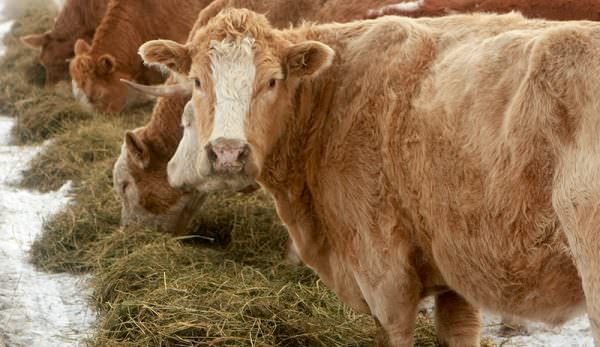
After a summer drought, winter-forage management can be difficult for farmers who keep livestock, but some foresight and planning can help eliminate a forage shortage. Unfortunately, there are no cheap, easy fixes for beef producers who have short pastures and limited hay supplies. In order to maximize herd health and minimize long-term economic consequences, you should develop a plan for winter feeding long before the last blade of grass or bale of hay disappears. In the meantime, there are steps you can take to manage supplies in the months ahead.
As you implement your winter feeding program, continue to pay close attention to your cows’ body condition scores, making adjustments as needed to ensure optimal herd health.
If you haven’t already, take time to have forage analyzed for nutrient profiles in order to determine supplemental feed needs. Obtain representative samples from each field and harvest date and have a certified forage-testing lab analyze them. Find a lab in your area by contacting your local cooperative-extension office or the National Forage Testing Association (402-466-7677). A basic analysis will tell you the amount of dry matter, energy, crude protein (adjusted for heat damage), neutral detergent fiber, calcium, phosphorous, potassium and magnesium. From this profile, a safe diet can be formulated to meet your herd’s needs in a cost-effective manner.
We also recommend conducting an inventory of hay and other feed resources. For planning purposes, assume that a cow will consume, at minimum, about 2.5 percent of its body weight in average-quality hay per day on a dry matter (DM) basis, but when waste is factored in, about 3 percent of the cow’s body weight will disappear from inventory. Hay stored outdoors has about 20-percent wastage (i.e., a waste factor of 1.2); hay stored indoors has about 7 percent (or 1.07 WF). A series of formulas can help you estimate winter-forage needs for your herd. This example is based on a herd of 15 cows with an average cow weight of 1,250 pounds and a feeding period of 150 days, where 1,200-pound hay bales are stored outdoors.
To calculate DM disappearance per cow per day:
Average Weight (1,250 pounds)
x Percent Weight Consumed (.025)
x Waste Factor (1.2)
= Pounds of Hay DM Disappearance Per Cow, Per Day (37.5 pounds)
To determine per-cow DM needs for the given feeding period:
DM Disappearance (37.5 pounds)
x Feed Period (150 days)
= Amount of Hay DM Per Day (5,625 pounds)
Bales stored indoors typically contain 88 percent DM, while bales stored outdoors typically contain about 80 percent DM. Dry matter content also depends on where hay was harvested, as well as on climatic conditions where the herd is maintained. Forage testing will yield this information.
To calculate each bale’s DM weight:
Bale Weight (1,200 pounds)
x Percent DM (0.8)
= Amount of Hay DM Per Bale (960 pounds)
To calculate per-cow hay needs:
DM Needs Per Cow (5,625 pounds)
÷ Hay DM Per Bale (960 pounds)
= Bales Per Cow for the Feeding Period (5.9 bales)
To calculate herd hay needs for the feeding period:
Hay Needs Per Cow (5.9 bales)
x Number of Cows (15)
= Bales of Hay Needed for the Winter Feeding Period (88.5 bales)
If your estimate reveals that you’ll come up short in meeting your herd’s nutritional needs, consider stretching supplies with alternative feeds, such as crop residues. Although these aren’t direct substitutes for high-quality hay or pasture, when properly supplemented, they can satisfy nutritional requirements.
Decrease waste and enhance herd health by implementing an appropriate feeding system for forage and supplemental feeds. Feeding hay on the ground will result in higher losses and waste of these scarce resources; it can also have negative health effects. Use a hay-feeding rack to store forage and regulate intake, and select a well-designed portable mineral feeder with a roof to protect it from moisture.
You can also limit hay access time to stretch forage supplies. Several studies from Purdue have shown that beef producers can stretch their supplies of moderate-quality, orchardgrass-alfalfa hay by limiting access to round bales to six to eight hours per day without significantly impacting cows’ weights or body condition scores. Total hay DM disappearance was reduced by 17.6 percent when cows had access to hay for eight hours per day versus 24 hours per day. When limiting access time, make sure all cows have equal and simultaneous access and that nutrients are supplemented as needed based on a forage analysis. Additionally, when cows are limit-fed, it’s important to realize that free-choice consumption of a vitamin-mineral mix can exceed the desired daily level, and it might be necessary to add additional salt as an intake limiter to achieve the desired level of mineral intake.
About the Authors: Ronald P. Lemenager is a professor of animal sciences at Purdue University and Keith D. Johnson is a professor of agronomy at Purdue University. Dr. Lyle G. McNeal is a livestock specialist in the Department of Animal, Dairy and Veterinary Sciences at Utah State University.
This article first appeared in the January/February 2013 issue of Hobby Farms.




